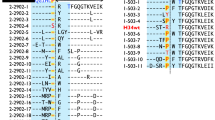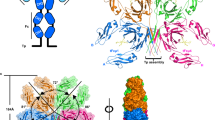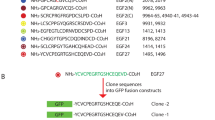Abstract
IT was observed that treatment of the heavy chain of normal rabbit immunoglobulin G (IgG) with cyanogen bromide in 70 per cent formic acid split the chain into sections suitable for amino-acid sequence studies. Cyanogen bromide reacts with methionine residues converting them to homoserine with simultaneous splitting of the peptide chain and leaving the homoserine residue C-terminal1. Particularly the C-terminal octadecapeptide was easily isolated in high yield and its sequence was determined2. The heavy chain of human IgG from normal serum3 and a pathological serum4 both had the same C-terminal sequence and this differed from that of the rabbit in only two of the eighteen residues, suggesting that there might be a characteristic pattern for all mammalian IgG. The heavy chain of horse IgG has been investigated by the same technique and compared with the heavy chain of the horse T protein. The latter immunoglobulin is barely detectable in normal serum but increases very considerably in the serum of a horse strongly immunized with protein antigens such as diphtheria or tetanus toxoid and it may contain almost all the antibody5,6. This protein has a high carbohydrate content and it has been suggested that it might be the equine equivalent of human IgA. From a study of the antigenic cross-reactions of the whole proteins and their subunits, however, this seemed unlikely7.
This is a preview of subscription content, access via your institution
Access options
Subscribe to this journal
Receive 51 print issues and online access
$199.00 per year
only $3.90 per issue
Buy this article
- Purchase on Springer Link
- Instant access to full article PDF
Prices may be subject to local taxes which are calculated during checkout
Similar content being viewed by others
References
Gross, E., and Witkop, B., J. Biol. Chem., 237, 1856 (1962).
Givol, D., and Porter, R. R., Biochem. J., 97, 32C (1965).
Piggot, P. J., and Press, E. M., Biochem. J., 99, 16P (1966).
Press, E. M., Piggot, P. J., and Porter, R. R., Biochem. J., 99, 356 (1966).
Kekwick, R. A., and Record, B. R., Brit. J. Exp. Path., 22, 29 (1941).
Van der Scheer, J., and Wyckoff, R. W. G., Proc. Soc. Exp. Biol. Med., 43, 427 (1940).
Weir, R. C., and Porter, R. R., Biochem. J., 100, 63 (1966).
Prahl, J. W., Proc. Roy. Soc., B, 166, 108 (1966).
Cebra, J. J., and Robbins, J. B., J. Immunol., 97, 12 (1966).
Cebra, J. J., and Small, P. A., Biochemistry (in the press).
Author information
Authors and Affiliations
Rights and permissions
About this article
Cite this article
WEIR, R., PORTER, R. & GIVOL, D. Comparison of the C-terminal Amino-acid Sequence of Two Horse Immunoglobulins IgG and IgG(T). Nature 212, 205–206 (1966). https://doi.org/10.1038/212205a0
Issue Date:
DOI: https://doi.org/10.1038/212205a0
This article is cited by
-
Inter Heavy–Light Chain Disulphide Bridge in Immune Globulins
Nature (1967)
-
Structure of Antibody Molecules
Nature (1967)
Comments
By submitting a comment you agree to abide by our Terms and Community Guidelines. If you find something abusive or that does not comply with our terms or guidelines please flag it as inappropriate.



